The people of the Seychelles are very proud of their history and have made sure they have preserved that history. As such, there are many national monuments worth visiting when in the Seychelles, and we have listed the monuments on Mahe below with some information on each. There are truly some interesting places to see! To visit these monuments or to book your holiday with us, contact us at www.seychellesyachtcharter.com
Bel Air Cemetry, Bel Air, Mahe
The Bel Air Cemetery, undoubtedly the oldest historic site in Seychelles, was the first official burial ground to be opened on Mahé soon after the establishment of the French settlement in the late 18th century. Important historical milestones, the cemetery’s tombs, vaults and shrines contain the remains of some of the islands’ most famous personalities such as corsair Jean-Francois Hodoul and the 9ft giant Charles Dorothée Savy, poisoned at the age of 14 by neighbours fearful of his height.
Another character whose remains lie within the cemetery is the mysterious Pierre-Louis Poiret, claimed by some to be the son of Louis XVI who fled the French Revolution and took refuge in Seychelles. It is also a final resting place of a son-in-law of Quéau de Quinssy, a magistrate, an acting civil commissioner and a district magistrate who lies among other recently rediscovered graves once covered by the great landslide of 1862.

Bicentennial Monument, Victoria, Mahe
Standing on the roundabout at the 5th of June and Liberation Avenues is the Bicentennial Monument. They are three pairs of extended masonry white wings, plain and simple, and often leave visitors guessing at their significance.
Referred to in Creole as the Moniman trwa lezel (three–winged monument), iIt was erected in 1978 to commemorate the 200th anniversary of the town of Victoria, which was founded as L’Établissement du Roi in 1778 by the Frenchman Charles Routier de Romainville. The monument was created by the late Italian artist Lorenzo Appiani, who lived in Seychelles.
The three wings represent the origins of the Seychellois people, who can best be described as a happy blend of the ethnic groups of three continents: Africa, Europe, and Asia. The wings may also symbolize the first discoverers of the islands, which of course were the birds!

Grann Kaz, Mahe
A traditional homestead that is in perfect condition, the Domaine de Val des Près recalls the simplicity and charm of Creole life as it was at the beginning of the 20th Century. Together with the adjoining buildings the homestead harmoniously displays an ensemble of original architectural features. The ‘Grann Kaz’ consists of a large sitting room, a dining room, three bedrooms and a surrounding veranda. This splendid house is sparsely furnished with a few period pieces. The adjoining buildings constitute a craft village where a group of 12 workshops provide traditional Seychelles crafts and a restaurant that offers the spicy delights of our Creole cuisine. This place offers visitors and residents a nostalgic glimpse of Creole life of yesteryears.

Kenwyn House, Francis Rachel Street, Victoria, Mahe
Kenwyn House was built circa 1855. The first person to live in the house was the chief medical officer at the time- a Dr. James Henry Brooks. Dr. Brooks was the chief medical surgeon as well as the German consulate to the Seychelles from 1858 - 1879 (He died in 1920 at age 89yrs).
In 1878 Cable & Wireless (Formerly the 'Eastern Telegraphic Company') purchased the Kenwyn House from Dr. Brooks. The chief engineers for Cable & Wireless resided at Kenwyn House whilst they were here setting up global communications for the Seychelles. There is a general consensus that C&W were the ones to give the house the name "Kenwyn House" - named after a village in Cornwall. Towards the end of the 20th century C&W used Kenwyn House as a residence for their general managers.
One of Seychelles’ most renowned and photographed monuments, Kenwyn House is a must-see for visitors exploring the Seychelles capital Victoria. An elegant example of French colonial architecture, Kenwyn House now offers visitors a chance to explore this historic national monument while browsing a world-class selection of crafted South African diamonds and other precious gems at duty-free prices, as well as an array of gifts and souvenirs. Visitors can also enjoy refreshments in its adjacent tropical garden and gaze at the work of top Seychellois artists in the Kenwyn House gallery.

Kreole Institute, Mahe
The Kreole Institute, established to promote Creole culture and tradition, forms part of the Patrimwann. Designed by a German architect, Leit, it was built in 1920 by France Jumeau, a plantation owner at the time. Its former name was Maison St. Joseph, and is a large colonial house built in the French style and reflects the opulence of the grand property owners of that era.
Activities that take place at the Kreole Institue include formal, traditional balls, traditional French song recitals, cultural exhibitions, language and literature workshops. It also houses a documentation centre.

La Bastille, Victoria, Mahe
La Bastille was built by Ange Pillieron after the design of Alfredo Leit. It left the Pillieron family in 1973 and was then occupied by the Survey Division followed by the Ministry of Education in 1975. It was home to the National Archives from 1981 – mid 1990’s but today La Bastille fittingly houses the National heritage division of the Ministry of The Arts, Culture and Sports.

La Domus, Victoria, Mahe
La Domus is the residence of the Roman Catholic priesthood in Victoria and was an outstanding architectural achievement of its time. Built in 1934 to house the Swiss missionaries ministering to the Diocese of Port Victoria, the magnificent two-storey building constructed from granite rocks even contains an aqueduct that supplies it with water from a nearby artesian well.
In the 1960’s it housed a dozen Capuchin missionaries. Today La Domus is occupied by only three priests with many of its rooms used as administrative offices and stands in a quiet corner of Victoria.

La Grand Trianon Marie-Antoinette Restaurant, St. Louis, Mahe
The Marie-Antoinette is housed in a colonial mansion with unique creole architecture, and is well over a hundred years old. The restaurant prides itself upon a time-honoured menu that includes traditional creole cuisnie dishes such as tuna steak, battered parrot fish, aubergine fritters, chicken curry, grilled fresh red snapper, fresh local salad, chutneys and local desserts featuring local sorbets. The house which was the first convent in the Seychelles, is now a national monument.

National Museum of History, Victoria, Mahe
Established in 1964, the National Museum of History is charged with the acquisition, preservation and exhibition of historical artefacts for the benefit of the public. Exhibits illustrating the history of Seychelles include such items as the oldest map drawn in 1517, the Stone of Possession, the world’s smallest statuette of Queen Victoria, and objects of ethnographical interest that exemplify the traditions and modes of life in times gone past.

Seychelles National Botanical Gardens, Mont Fleuri, Mahe
Dating back more than a century, the national botanical gardens is one of the oldest monuments. It houses a wide collection of mature, exotic and endemic plants within five acres of landscaped and beautifully maintained tropical gardens.
The garden is home to a wide variety of spice and fruit trees most of which can only be seen in this garden. An added attraction is the population of giant tortoises from Aldabra, some of which are over 150 years old. Fruit bat colonies can be found feeding or roosting in the taller trees overhead, and the latest feature is an orchid house which holds a collection of brightly coloured orchids including Seychelles’ own native orchids.

St. Paul’s Cathedral, Victoria, Mahe
St. Paul’s is both the Cathedral of the Diocese and the Anglican parish church of Victoria and is a prominent landmark. The building has been extended twice, with a new tower in 1910, and with a relocated sanctuary in 1978. The original church was dedicated to St. Paul the Apostle and stood on the site of the present Cathedral. It was consecrated on 14 May 1859 by the first Bishop of Mauritius, Vincent William Ryan. In December 1920, St. Paul’s became a Pro-Cathedral, where the Bishop had his second “cathedra” (Bishop’s chair) and the Diocese’s name changed from Mauritius to the Diocese of Mauritius and Seychelles.
With space always a constraint and maintenance difficult and costly, it was decided to completely rebuild the structure in 2001. The now boasts a doubled capacity of 800 and was made possible through generous donations from the public and government.

Victoria Clocktower, Victoria, Mahe
The Victoria Clocktower is the most prominent feature of Seychelles’ small capital, and has acted as a focal point for nearly 100 years. While all around massive transformation has taken place in the town centre, with modern buildings of concrete and glass springing up, the Clocktower has remained virtually unchanged. Made by Messrs Gillet and Johnson of Croydon, and paid for partly by public subscription, the clock was erected in Victoria in 1903, the same year that Seychelles celebrated its new status as a Crown colony, administered directly by a governor appointed by London instead of from Mauritius.
Originally, the clock was expected to chime, but sadly failed to do so. Today, however, the Victoria clock regularly strikes the hour, having had its mechanism completely replaced in 1999 by a modern, quartz masterclock. The work was carried out by the original manufacturer, Gillett and Johnson, with the cost again being met in Seychelles partly by public donation.

Zomn Lib Liberation Monument, Victoria, Mahe
This monument represents a major political landmark in the history of Seychelles. To all Seychellois people who revolted against colonialist oppression and injustice on the 5th June 1977, it is a powerful symbol of liberty. It is a metal statue in the form of a robust masculine figure with both arms raised high, its clenched fists freed from chains, demonstrating triumphant defiance and victory for a truly independent nation.
The Liberation Monument was inaugurated in 1978 by the President of the Second Republic, who dedicated it to the Martyrs of the Revolution. In March 1989 marble steps were added to the granite plinth on which it stands, flanked by the National flags.
Since 1978, every 5th of June has been a public holiday, when wreaths and flowers are laid at the “Zonm Lib” by dignitaries and ordinary citizens. In the aftermath of a multi-party democracy, this monument symbolises Seychelles’ spirit of revolutionary fervour and the commitment of the Seychellois people to carry the banner of peace, harmony, and freedom into the future.

Part 2: Li Digue and Silohouette Islands coming soon!



























